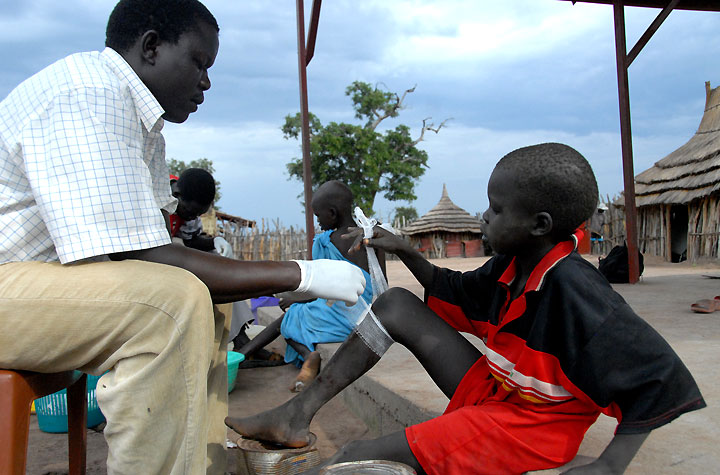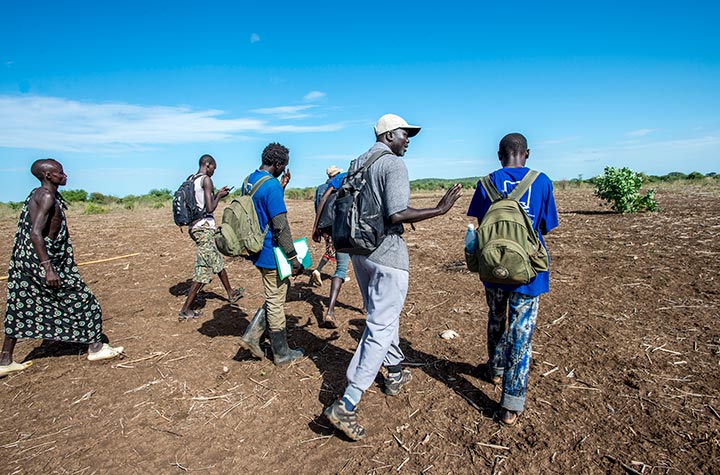

Former U.S. President Jimmy Carter tries to comfort 6-year-old Ruhama Issah at Savelugu (Ghana) Hospital as a Carter Center technical assistant dresses Issah's extremely painful Guinea worm wound. In May 2010, with Carter Center support, Ghana reported its last case of Guinea worm disease and announced it had stopped disease transmission a year later.
Location: Savelugu, Ghana | Date: Feb. 8, 2007 | Photo: The Carter Center/L. Gubb
Download High-Resolution Image

The Guinea Worm Containment Centre in Ogi, Nigeria, provided medical care for people affected by Guinea worm disease. With Carter Center support, Nigeria, previously the world’s most endemic country, reported its last case of Guinea worm disease in November 2008 and was certified free of Guinea worm by the World Health Organization in 2013.
Location: Nigeria | Date: 2004 | Photo: The Carter Center
Download High-Resolution Image

At Savelugu Hospital in Northern Region, Ghana, former U.S. President Jimmy Carter and his wife, Rosalynn, watch as a Guinea worm health worker dresses a child's extremely painful Guinea worm wound. In May 2010, with Carter Center support, Ghana reported its last case of Guinea worm disease and announced it had stopped disease transmission a year later.
Location: Savelugu, Ghana | Date: Feb. 8, 2007 | Photo: The Carter Center/L. Gubb
Download High-Resolution Image

Guinea worms are thin, thread-like parasites. Inside the human body, they can grow up to three feet long (one meter) before emerging through the skin.
Location: n/a | Date: n/a | Photo: The Carter Center
Download High-Resolution Image

A local volunteer in South Sudan uses a flip chart to educate villagers on Guinea worm disease prevention. Harboring the vast majority of the world's remaining cases, South Sudan has become the last frontier on the difficult path to eradicating this debilitating parasitic disease.
Location: Southern Sudan | Date: 2008 | Photo: The Carter Center/J. Albertson
Download High-Resolution Image

A sign warns those with Guinea worm disease not to enter the water. When the worms create agonizingly painful blisters in the skin, through which they slowly exit the body, people often seek relief by soaking in water. However, when people with emerging worms bathe or step in sources of drinking water, a worm will release hundreds of thousands of eggs, or larvae, into the water. Water fleas then eat the larvae, and people who drink unfiltered water from the pond become infected — continuing the life cycle of the parasite.
Location: Taha, Ghana | Date: March 2006 | Photo: The Carter Center
Download High-Resolution Image

Guinea worm disease is a major impediment to a farmer's ability to work. Dressed in his farming clothes, Nuru Ziblim, a Guinea worm health volunteer in Ghana, educates children on how to use pipe filters when they go to the fields with their families. Pipe filters, individual filtration devices worn around the neck, work similarly to a straw, allowing people to filter their water to avoid contracting Guinea worm disease while away from home. In May 2010, with Carter Center support, Ghana reported its last case of Guinea worm disease and announced it had stopped disease transmission a year later.
Location: Ghana | Date: February 2008 | Photo: The Carter Center/L. Gubb
Download High-Resolution Image

A young child in South Sudan is comforted by South Sudan Guinea Worm Eradication Program Director Makoy Samuel Yibi as a volunteer health worker extracts an emerging Guinea worm. Harboring the vast majority of the world's remaining cases, South Sudan has become the last frontier on the difficult path to eradicating this debilitating parasitic disease.
Location: Southern Sudan | Date: 2008 | Photo: The Carter Center/J. Albertson
Download High-Resolution Image

Some people, especially nomadic groups, receive pipe filters, which are small straw-like personal filters that can be worn around the neck. These simple but revolutionary devices enable people to drink water without the threat of contracting Guinea worm disease no matter where they are. Recently, Vestergaard extended their 2010 in-kind donation of the LifeStraw® Guinea worm cloth and pipe filters to the Carter Center’s Guinea Worm Eradication Program through 2016. Vestergaard has been a partner of the Center’s health programs since 1999.
Location: Savelugu, Ghana | Date: July 11, 2006 | Photo: The Carter Center/L. Rotondo
Download High-Resolution Image

A woman in the village of Ogi, Nigeria, filters drinking water using a simple cloth filter. With Carter Center support, Nigeria, previously the world’s most endemic country, reported its last case of Guinea worm disease in Nov. 2008 and was certified free of Guinea worm by the World Health Organization in 2013.
Location: Nigeria | Date: 2004 | Photo: The Carter Center
Download High-Resolution Image

At age six, Sadia Mesuna spent two months at the Carter Center's Guinea worm containment center in Savelugu, Ghana, for treatment of the painful disease. A year later, Sadia was Guinea worm-free and could again participate in her family's daily activities. In May 2010, with Carter Center support, Ghana reported its last case of Guinea worm disease and announced it had stopped disease transmission a year later.
Location: Savelugu, Ghana | Date: Feb. 23, 2008 | Photo: The Carter Center/L. Gubb
Download High-Resolution Image

Patients with Guinea worm disease soak their hanging worms or wounds prior to their daily morning treatment at containment centers to facilitate easier removal and control the release of Guinea worm larvae.
Location: Savelugu, Ghana | Date: Feb. 4, 2007 | Photo: The Carter Center/L. Gubb
Download High-Resolution Image

This Nigerian woman is gathering water from a local pond, which is used as a source of drinking water. However, to prevent Guinea worm disease, this water must be filtered in order to remove the copepods (water fleas) that carry the parasitic larvae of the Guinea worm. With Carter Center support, Nigeria, previously the world’s most endemic country, reported its last case of Guinea worm disease in November 2008 and was certified free of Guinea worm by the World Health Organization in 2013.
Location: Nigeria | Date: 2004 | Photo: The Carter Center
Download High-Resolution Image

The emerging Guinea worm is wound around a moist bandage to prevent it from breaking.
Location: Savelugu, Ghana | Date: Feb. 6, 2007 | Photo: The Carter Center/L. Gubb
Download High-Resolution Image

Education is an important part of surveillance and case reduction. Here, flip charts are used to show schoolchildren how Guinea worm disease is contracted, and what they must do to prevent it. Education and low-technology measures to promote behavioral change are especially important because there is no medicine or vaccine to prevent Guinea worm disease.
Location: Wantugu, Ghana | Date: March 16, 2006 | Photo: The Carter Center/E. Staub
Download High-Resolution Image

In the village of Ogi, Nigeria, a village volunteer inspects the length of a Guinea worm emerging from a man's calf. Nigeria was once the most Guinea worm-endemic country in the world reporting over 650,000 cases in 1988. With Carter Center support, Nigeria reported its last case of Guinea worm disease in November 2008 and was certified free of Guinea worm by the World Health Organization in 2013.
Location: Nigeria | Date: 2004 | Photo: The Carter Center
Download High-Resolution Image

While at the containment center in Savelugu, Ghana, Sadia Mesuna and her friend Fatawu Yakubu look at a picture book about Guinea worm disease, learning that "you get Guinea worm from the water. If you drink it unfiltered, you get Guinea worm," Sadia said. In May 2010, with Carter Center support, Ghana reported its last case of Guinea worm disease and announced it had stopped disease transmission a year later.
Location: Savelugu, Ghana | Date: Feb. 5, 2007 | Photo: The Carter Center/L. Gubb
Download High-Resolution Image

Volunteer Sulley Zakari treats Hubeida Iddirisu at her home in Ghana in February 2007. Iddirisu had three painful Guinea worms emerging from her body that year. In May 2010, with Carter Center support, Ghana reported its last case of Guinea worm disease and announced it had stopped disease transmission a year later.
Location: Savelugu, Ghana | Date: Feb. 4, 2007 | Photo: The Carter Center/L. Gubb
Download High-Resolution Image

Displacement by war and nomadic lifestyles in South Sudan make pipe filters — distributed to men, women, and children — an important tool against contracting Guinea worm disease. Harboring the vast majority of the world's remaining cases, South Sudan has become the last frontier on the difficult path to eradicating this debilitating parasitic disease.
Location: Southern Sudan | Date: 2008 | Photo: The Carter Center/J. Albertson
Download High-Resolution Image

Former U.S. President Jimmy Carter asks Ghanaian children outside Savelugu Hospital, "Who here has had Guinea worm disease?" Amid the scorching heat of peak dry season, President Carter visited the parched community of Savelugu to meet with dozens of Guinea worm disease victims in an effort to bring global attention to Ghana's growing Guinea worm epidemic caused by inadequate water supply in the country. In May 2010, with Carter Center support, Ghana reported its last case of Guinea worm disease and announced it had stopped disease transmission a year later.
Location: Savelugu, Ghana | Date: Feb. 8, 2007 | Photo: The Carter Center/L. Gubb
Download High-Resolution Image

A woman uses a Carter Center-donated fine mesh filter cloth fitted over a clay pot used to hold water. Filtering the tiny water fleas out of drinking water is the most effective way to prevent Guinea worm disease.
Location: Togo | Date: March 1, 2001 | Photo: The Carter Center
Download High-Resolution Image

Displacement by war and nomadic lifestyles in South Sudan make pipe filters — distributed to men, women, and children — an important tool against contracting Guinea worm disease. Harboring the vast majority of the world's remaining cases, South Sudan has become the last frontier on the difficult path to eradicating this debilitating parasitic disease.
Location: Kuse Dam, Terekeka County, South Sudan | Date: February 2010 | Photo: The Carter Center/L. Gubb
Download High-Resolution Image

At a Guinea worm case containment center in Abuyong, South Sudan, six-year-old Thom Mayom assists nurse John Lotiki as Lotiki tends to the badly infected Guinea worm wound in Mayom’s knee. Harboring the vast majority of the world's remaining cases, South Sudan has become the last frontier on the difficult path to eradicating this debilitating parasitic disease.
Location: Abuyong, South Sudan | Date: November 2010 | Photo: The Carter Center
Download High-Resolution Image

The South Sudan Guinea Worm Eradication Program surveillance team, led by Makoy Samuel Yibi (grey shirt and white hat) explore villagers' gardens and water sources where four female Guinea worm disease patients from nearby Loruonomor "Black Stones" Village worked a year before. Surveillance to locate potentially contaminated water sources, as well as to find, treat, and contain the final cases, is an important component of the Guinea Worm Eradication Program.
Location: Mogos South, South Sudan | Date: May 2013 | Photo: The Carter Center/L. Gubb
Download High-Resolution Image
